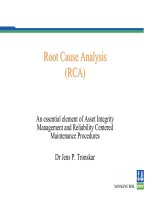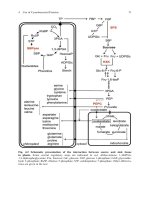Essential Concepts of Electrophysiology through Case Studies-Intracardiac EGMs 2
Bạn đang xem bản rút gọn của tài liệu. Xem và tải ngay bản đầy đủ của tài liệu tại đây (18.23 MB, 134 trang )
3
Part
Atrial
Fibrillation
(AF)
Case
3.A
Question
A 67-year-old man underwent catheter ablation for
drug-refractory atrial fibrillation.
Following circumferential ablation around both
sets of pulmonary veins, pacing was performed from the
circular mapping catheter to assess for exit block. The
pacing output is decreased over the course of the recording. Catheter position is shown in the RAO and LAO
projections.
What should be done next?
A) Additional ablation to isolate the left pulmonary
veins
B) Additional ablation to isolate the right pulmonary
veins
C) Additional ablation within the left atrial
appendage
D) No further ablation is needed
191
192
Essential Concepts of Electrophysiology and Pacing through Case Studies
Figure 3.A.1
PART 3: Atrial Fibrillation (AF)
Figure 3.A.2
•
Case 3.A
193
194
Essential Concepts of Electrophysiology and Pacing through Case Studies
Answer
The correct answer is D. The circular mapping catheter is positioned in the left superior pulmonary vein and the ablation catheter
in the left atrial appendage. Pacing is performed from the circular
mapping catheter. Initially, the left atrial appendage is captured
directly, as suggested by immediate activation recorded by the
ablation catheter. As the pacing output is decreased, capture of the
pulmonary vein is preserved (arrows), while far-field capture of the
left atrial appendage (stars) is lost.
Thus, exit block is present in the left pulmonary veins, and
further ablation is not needed. No conclusion can be drawn
about the right pulmonary veins with this catheter position. No
evidence is provided of triggers from the left atrial appendage.
Far-field capture of the left atrial appendage is not
uncommon when pacing the anterior aspect of the left superior
pulmonary veins. Similarly, far-field capture of the superior
vena cava can occur when pacing deep within the right superior
pulmonary vein. When far-field capture is suspected, pacing at
lower output should be performed. If pulmonary vein capture is
preserved while atrial capture is lost, exit block is truly present,
and further ablation should not be delivered.
References
1.
Gerstenfeld EP, Dixit S, Callans D, Rho R, Rajawat Y, Zado E, et al.
Utility of exit block for identifying electrical isolation of the pulmonary veins. J Cardiovasc Electrophysiol. 2002;13:971–979.
2.
Vijayaraman P, Dandamudi G, Naperkowski A, Oren J, Storm R,
Ellenbogen KA. Assessment of exit block following pulmonary vein
isolation: far-field capture masquerading as entrance without exit
block. Heart Rhythm. 2012;9:1653–1659.
PART 3: Atrial Fibrillation (AF)
Figure 3.A.3
•
Case 3.A
195
Case
3.B
Question
A 52-year-old man undergoes pulmonary vein isolation
B) Position the ablation catheter along the antrum of
because of symptomatic, drug-refractory atrial fibrillation.
the LSPV closest to the proximal ring electrode
A circular mapping catheter is positioned along the an-
and deliver RF energy
trum of the left superior pulmonary vein (LSPV), where
C) Pace the left atrial appendage (LAA) to determine
wide-area circumferential ablation is begun. The follow-
if the signals seen on the circular mapping
ing tracing is recorded after the 17th radiofrequency (RF)
catheter are far-field arising from the LAA
lesion around the vein.
What is the next best option?
A) Position the ablation catheter on the antrum of
the LSPV closest to the third ring electrode and
deliver RF energy
196
D) Pace within the LSPV to see if exit block exists
PART 3: Atrial Fibrillation (AF)
Figure 3.B.1
•
Case 3.B
197
198
Essential Concepts of Electrophysiology and Pacing through Case Studies
Answer
The correct answer is D. After RF delivery, the circular mapping
catheter records low-amplitude atrial electrograms and absence of
pulmonary vein potentials on all electrodes except two (proximal,
third) both of which record high-frequency signals (arrows) that
might represent residual pulmonary vein conduction. Aside from
pulmonary vein potentials, another source of signals on a mapping
catheter in the LSPV are far-field atrial electrograms originating
from the LAA, particularly on the electrodes closest to the LAA.
These can be differentiated from true pulmonary vein potentials by
directly capturing the LAA. Close inspection of these signals on the
proximal and third-ring electrode, however, show that not only are
they completely simultaneous and “mirror images” of each other
but also demonstrate variability in timing with the truly captured
atrial electrograms. This indicates that they are actually recording
artifacts mimicking pulmonary vein potentials resulting from intermittent beat-to-beat contact between these two adjacent electrodes.
Since these high-frequency signals are neither atrial nor pulmonary
vein in origin, and that entrance block into the LSPV is otherwise
present, the next best option is to confirm coexistent exit block
and then move on to the next vein.
PART 3: Atrial Fibrillation (AF)
Figure 3.B.2
•
Case 3.B
199
200
Essential Concepts of Electrophysiology and Pacing through Case Studies
References
1.
2.
Haïssaguerre M, Jaïs P, Shah DC, et al. Spontaneous initiation of atrial
3.
Shah D, Haïssaguerre M, Jaïs P, Hocini M, Yamane T, Macle L, et al.
fibrillation by ectopic beats originating in the pulmonary veins. N Engl
Left atrial appendage activity masquerading as pulmonary vein poten-
J Med. 1998;339:659–666.
tials. Circulation. 2002;105:2821–2825.
Lemoa K, Oral H, Chugh A, et al. Pulmonary vein isolation as an
endpoint for left atrial circumferential ablation of atrial fibrillation.
J Am Coll Cardiol. 2005;46:1060–1066.
Case
3.C
Question 1
An 80-year-old man without history of arrhythmia undergoes mapping of atrial flutter. Entrainment mapping is
performed from different anatomic sites.
Which region should be targeted with ablation?
A) Cavotricuspid isthmus
B) Mitral isthmus
C) Left superior pulmonary vein
D) Left side of septum
E) Left atrial roof
201
202
Essential Concepts of Electrophysiology and Pacing through Case Studies
Figure 3.C.1
PART 3: Atrial Fibrillation (AF)
Figure 3.C.2
•
Case 3.C
203
204
Essential Concepts of Electrophysiology and Pacing through Case Studies
Answer 1
The correct answer is B. Mitral isthmus flutter is suggested by
entrainment mapping.
The flutter waves on the surface leads are not typical of
cavotricuspid isthmus flutter. In the setting of atrial fibrosis (seen in
this patient) and prior ablation, surface characteristics are less diagnostic. Distal-to-proximal coronary sinus activation is suggestive
of clockwise mitral annular flutter. Roof flutter typically results
in fusion of wavefronts in the coronary sinus. The coronary sinus
activation pattern is unlikely in a septal flutter and can be seen in
typical flutter from Bachmann bundle activation of the left atrium.
Entrainment shows long postpacing intervals from the
cavotriscuspid isthmus and left atrial roof, which suggests that
the circuit is remote from these anatomic regions. Entrainment
with short PPI from the proximal coronary sinus and left atrial
appendage, which is in close proximity to the anterolateral mitral
annulus, is highly suggestive of mitral isthmus flutter. Inferior and
anterior ablation lines connecting the mitral annulus to the left
inferior or right superior pulmonary vein can result in block across
the mitral isthmus. Note the annular signal of the entrainment
response from the mitral isthmus.
PART 3: Atrial Fibrillation (AF)
Figure 3.C.3
•
Case 3.C
205
206
Essential Concepts of Electrophysiology and Pacing through Case Studies
Question 2
During ablation, the following phenomenon is seen. What
should be the next step?
A) Discontinue radiofrequency application
immediately and monitor AV conduction
B) Re-map atrial flutter
C) Check for mitral block
D) Continue ablation
PART 3: Atrial Fibrillation (AF)
Figure 3.C.4
•
Case 3.C
207
208
Essential Concepts of Electrophysiology and Pacing through Case Studies
Answer 2
The correct answer is D. Ablation should be continued.
Ablation in the mitral isthmus is anatomically remote from
the AV node and left sided His and unlikely to result in heart
block. Additionally, the His catheter demonstrates 4:1 block at the
level of the AV node. The tachycardia cycle length is unchanged
(260 ms), although activation in the coronary sinus appears to
be different from the initial flutter. This suggests a transition to a
different flutter and/or the development of mitral block.
Coronary sinus (CS) electrograms represent a superimposition of far-field left atrial endocardial activation and near-field
epicardial component. Closer examination of the electrograms in
the CS demonstrate delay or block in the local CS musculature,
which gives the appearance that activation is reversed.
The far-field left atrial component, which reflects the endocardial left atrial activation, still proceeds from distal to proximal,
indicating that the same flutter continues. Misinterpretation of
CS musculature as left atrial endocardial activation is a common
pitfall when evaluating activation during flutter and mitral isthmus
block.
PART 3: Atrial Fibrillation (AF)
Figure 3.C.5
•
Case 3.C
209
210
Essential Concepts of Electrophysiology and Pacing through Case Studies
References
1.
2.
Miyazaki H, Stevenson WG, Stephenson K, Soejima K, Epstein LM.
3.
Pascale P, Shah AJ, Roten L, et al. Disparate activation of the coronary
Entrainment mapping for rapid distinction of left and right atrial
sinus and inferior left atrium during atrial tachycardia after persistent
tachycardias. Heart Rhythm. 2006;3(5):516–523.
atrial fibrillation ablation: prevalence, pitfalls, and impact on mapping.
Pascale P, Shah AJ, Roten L, et al. Pattern and timing of the coronary
J Cardiovasc Electrophysiol. 2012;23(7):697–707.
sinus activation to guide rapid diagnosis of atrial tachycardia after atrial
fibrillation ablation. Circ Arrhythm Electrophysiol. 2013;6(3):481–490.
Case
3.D
Question
During RF ablation to isolate the pulmonary veins, the
following bradyarrhythmia is observed.
Catheter position during the ablation lesion is
D) Increased vagal tone secondary to injury of the
phrenic nerve
E) Thermal injury to the sinus nodal artery
shown in the RAO and LAO projections.
What is the likely mechanism of this bradyarrhythmia?
A) Thermal injury to the sinus node
B) Thermal injury to the compact AV node
C) Increased vagal tone secondary to ablation of a
ganglionated plexus
211
212
Essential Concepts of Electrophysiology and Pacing through Case Studies
Figure 3.D.1
PART 3: Atrial Fibrillation (AF)
Figure 3.D.2
•
Case 3.D
213









